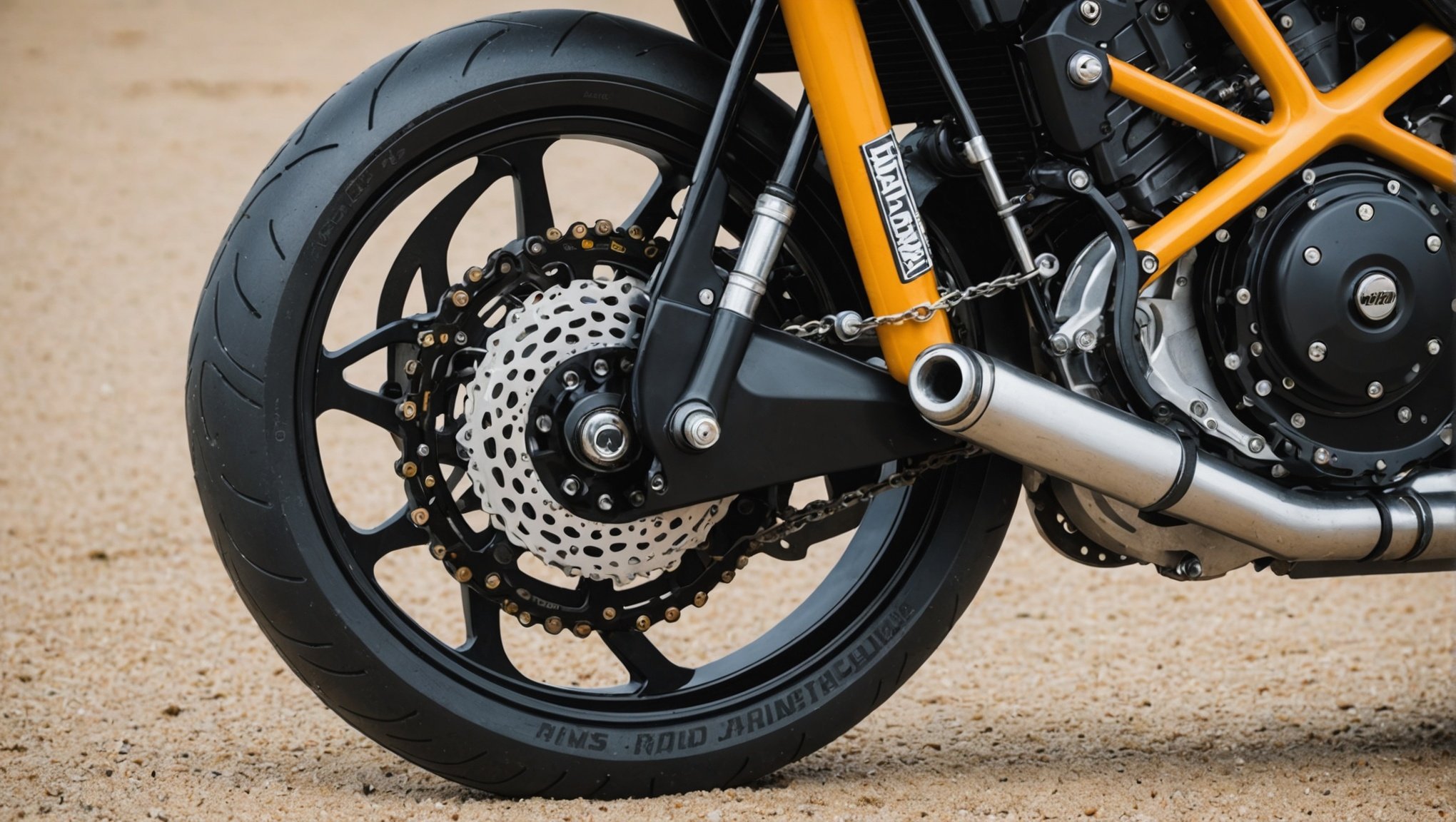Understanding the Impact of Sandy Beach Conditions on Sport Bike Chains
Navigating sandy beach conditions can pose significant challenges for sport bike enthusiasts, primarily affecting the integrity of the bike chain. Sand particles can work their way into the chain’s intricate links, leading to increased friction and potential wear. This situation is exacerbated by the presence of salt, which not only enhances friction but also promotes rust and corrosion, compromising the chain’s durability.
Sport bike chains are particularly vulnerable in such environments, as their precision engineering demands consistent resistance against contaminants. Common issues faced by riders include not only accelerated wear but also potential chain elongation, which can necessitate premature replacements. Salt, in combination with moisture, forms a particularly corrosive environment, often requiring more rigorous attention than under typical riding conditions.
Also read : Essential DIY Tools for Maintaining Your Sport Bike in the UK: A Comprehensive Guide
Regular maintenance becomes critical in preserving the chain and ensuring smooth operation. Riders should prioritize cleaning routines immediately after exposure to sandy environments. This involves washing away sand and salt residues, ensuring the chain remains lubricated to prevent rusting. Employing high-quality lubricants specifically designed to combat these harsh conditions can significantly extend the chain’s lifespan. Implementing these maintenance practices allows riders to enjoy their beachside adventures without compromising their sport bike’s performance.
Essential Maintenance Tips for Sport Bike Chains
Proper chain maintenance is crucial for both the longevity and performance of your sport bike, especially after beach rides. Sand and salt from the beach can quickly lead to corrosion if not addressed promptly. Start by thoroughly cleaning the chain after each beach outing. Use a chain cleaner or a mixture of water and mild detergent for best results.
Also to discover : Ergonomic Riding Adjustments for Sport Bikes: Tips to Minimize Fatigue on Long UK Journeys
Once clean, ensure the chain is completely dry to prevent moisture-induced corrosion. Next, apply a high-quality lubricant specifically designed for bike chains. Focus on ensuring even coverage through slow and consistent application.
Frequency of Maintenance
For those who frequent sandy conditions, it’s advisable to clean and lubricate your chain after every ride. Regular attention helps in performance enhancement by reducing friction, which eases the bike’s movement and improves fuel efficiency.
Visualization Techniques
Understanding the steps through visual aids can greatly improve your maintenance efficacy. Watching tutorials or images detailing the step-by-step chain cleaning and oiling process can streamline your routine, ensuring you don’t miss critical aspects.
Maintenance not only extends the life of your sport bike chain but also enhances overall performance, ensuring smoother rides. Embrace these habits for optimum results.
Recommended Products for Chain Care in Sandy Conditions
Maintaining chains in sandy environments requires specialised chain care products that guard against wear and tear. Key aspects to focus on include selecting lubrication, ensuring corrosion resistance, and using effective cleaning solutions.
Best lubricants for sandy environments
In sandy conditions, it’s crucial to choose lubricants that repel sand and dust while maintaining smooth chain movement. Dry lubricants are often preferred because they form a non-tacky layer on the chain, preventing sand from sticking. High-quality wax-based lubricants offer a protective barrier that minimizes dirt accumulation. Products containing Teflon or PTFE provide excellent performance in abrasive conditions.
Effective cleaning agents to remove sand and salt
Residue from sand and salt can corrode and jam chains. Therefore, investing in cleaning agents specifically designed for sandy conditions is essential. Biodegradable degreasers are environmentally friendly and effectively break down accumulated grime. Utilize alcohol-based solutions to dissolve salt deposits without harming metal surfaces. Regular cleaning extends the life and performance of chains significantly.
Protective coatings for chain longevity
Applying corrosion-resistant solutions to chains can significantly enhance their durability. Coatings with rust inhibitors provide a solid line of defence against moisture-induced corrosion. Ceramic coatings, although used less frequently, offer an upper hand in resisting friction and extending chain lifecycle in challenging environments. Regular application ensures enduring chain strength and optimal performance.
Step-By-Step Guide to Maintaining Your Chain
To maintain your chain effectively, it’s crucial to follow a detailed maintenance guide that highlights the chain cleaning process. Begin by ensuring your bike is securely positioned. Use a chain cleaner tool or a rag dipped in degreaser to remove dirt and grime comprehensively.
Chain Cleaning Process
- Remove the chain: If possible, detach the chain for a thorough clean.
- Degrease: Apply degreaser adequately, focusing on each link.
- Brush off debris: Use a stiff brush to scrub off stubborn dirt.
- Rinse: Wash off the degreaser with lightly soapy water and rinse thoroughly.
- Dry the chain: Use a clean, dry cloth to prevent rusting.
Lubrication Tips
Proper application of lubricant is essential after cleaning. Use a drip applicator, focusing on each link to ensure even coverage. Wipe off any excess lubricant to avert attracting additional grime.
Preventive Measures and Common Mistakes
Preventive measures can save both time and money. Implement a regular schedule based on your riding conditions. Avoid these common errors:
- Over-lubricating, which can attract more dirt.
- Neglecting to rinse off degreaser completely, leading to rust.
- Skipping chain drying, increasing potential for corrosion.
By adhering to these guidelines, you prolong the chain’s life and maximize performance.
Addressing Common Mistakes in Chain Care
Proper chain maintenance is crucial for optimizing bike performance, yet misconceptions often lead to simple mistakes. In sandy areas, many believe lubricating a chain excessively can prevent debris buildup. However, over-lubrication can actually worsen the problem, attracting more sand and grit, leading to wear.
After enjoying a beach ride, neglecting to clean your bike chain is common but detrimental. Salt and sand must be promptly rinsed off to prevent corrosion. A simple rinse and thorough drying can significantly prolong your chain’s life, ensuring smooth rides.
Prevention Advice for Optimizing Bike Performance
- Avoid over-lubrication: Apply just enough lubricant to reduce friction without attracting dirt.
- Post-ride cleaning: After beach rides, use a gentle water spray to clean your chain.
- Regular inspection: Examine your chain for signs of rust and wear to address issues early.
By following these prevention strategies, you can minimize corrosion risks and maximize your bike’s performance. Keeping your chain clean and correctly lubricated ensures your bike functions efficiently over time. With a bit of attention and consistent care, you can easily avoid these common chain maintenance mistakes.
Repairing Chain Damage Caused by Sandy Conditions
In sandy conditions, motorcycle chains can experience wear and damage more rapidly than usual. Recognizing these signs is crucial for maintaining optimal performance.
Identifying Wear and Damage
Regular inspection is essential. Look for signs such as rust, kinks, or unusual noises. Damage assessment involves checking for misalignment, worn sprockets, and stretched links. Neglecting these signs can lead to further complications, impacting both safety and durability.
Repair or Replace?
Once damage is identified, consider whether to repair or replace the chain. Minor issues like surface rust might be resolved with cleaning and lubrication. However, in cases of severe wear or broken links, opting for replacement advice is advisable. New chains ensure safer and more efficient rides, preserving the motorcycle’s overall condition.
If uncertain, reviewing different scenarios can be helpful:
- For slightly worn chains, regular lubrication can extend life.
- Severely damaged chains warrant immediate replacement.
- Continuous adjustment failures suggest the need for a new chain.
Seeking Professional Help
When damage assessment becomes complex, or if you’re unsure about the repair process, seeking professional help is prudent. Mechanics can provide chain repair expertise and advice tailored to your motorcycle’s needs, ensuring you get back on the road safely.






